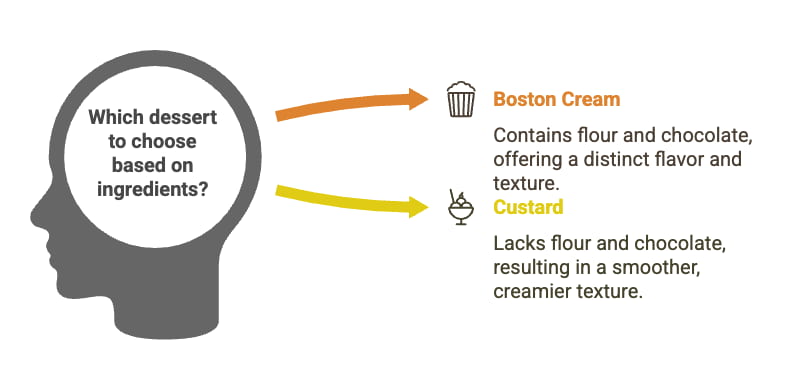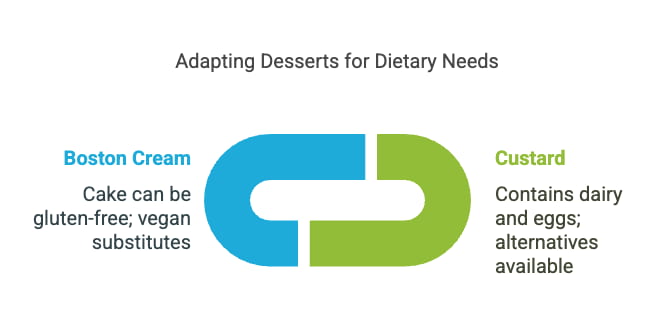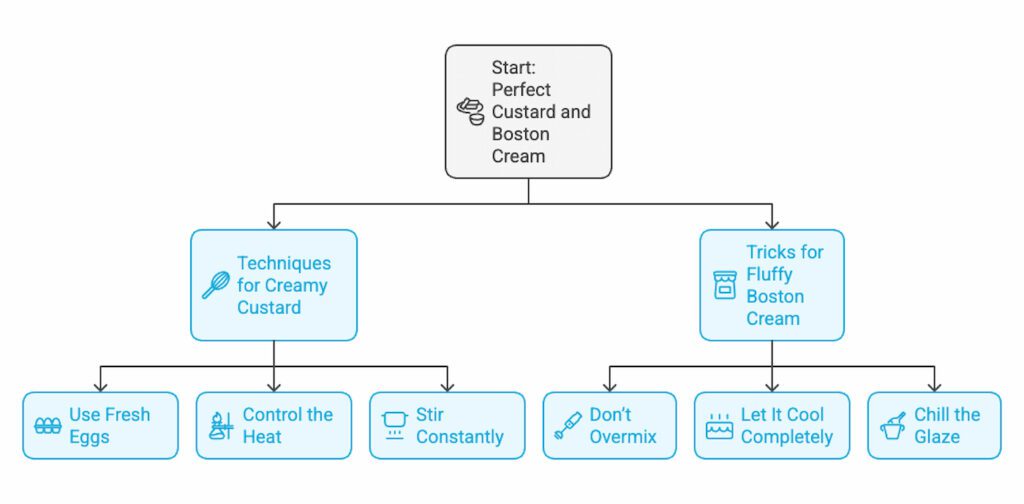When it comes to desserts, a few things spark debate, like the comparison between Boston cream and custard. Are they really that different? Or are they just two sides of the same delicious coin? In this article, we’ll dive deep into these two beloved treats, examining their origins, ingredients, and what sets them apart. So, grab a cup of coffee, settle in, and let’s explore the sweet world of Boston cream and custard!
Understanding the Basics: What is Custard?
Custard is a classic dessert that has been enjoyed for centuries. At its core, custard is a mixture of milk or cream, egg yolks, and sugar, cooked gently to create a smooth, creamy texture. But here’s where it gets interesting: there are many types of custard, from the thick, rich pastry cream used in éclairs to the lighter, pourable versions often served with fruit. It’s versatile, and you can use it as a base for other desserts or enjoy it on its own.
However, not all custards are created equal. The cooking method and ingredient ratios can change the final product dramatically. For instance, some custards are baked, while others are cooked on the stovetop. This leads to variations in texture and flavor, making custard a fascinating subject for any dessert lover.
If you’d like to explore custard’s versatility further, don’t miss Lemon Custard Cake: Baking Made Simple for a creative custard dessert recipe.
The Origins of Boston Cream
Now, let’s shift our focus to Boston Cream. This delightful treat is most famously known as the filling for Boston cream pie, which, ironically, isn’t a pie at all! Instead, it’s a cake filled with custard or cream and topped with chocolate glaze. The dessert hails from Boston, Massachusetts, and has a rich history dating back to the 19th century. It was created by a French chef named M. C. G. D. de la Varenne, who worked at the Parker House Hotel.
Furthermore, Boston cream pie became a symbol of American culinary innovation, blending French techniques with American flavors. It’s a perfect example of how food evolves over time, influenced by culture and creativity.
For more on crafting perfect Boston cream recipes, check out Boston Cream Cake: Secrets to the Perfect Afters.
Key Differences Between Boston Cream and Custard
So, what exactly sets Boston cream apart from custard? While they share some similarities, particularly in terms of ingredients, several key differences highlight their unique identities.
Ingredients Breakdown
Both Boston cream and custard contain similar foundational ingredients, but the proportions and additional components make all the difference. Here’s a quick breakdown:
| Ingredient | Custard | Boston Cream |
|---|---|---|
| Milk/Cream | Yes | Yes |
| Egg Yolks | Yes | Yes |
| Sugar | Yes | Yes |
| Flour | No | Yes (in cake) |
| Chocolate | No | Yes (for glaze) |
While both desserts share some common ingredients, Boston cream includes flour and chocolate, which are absent from traditional custard. This leads to a distinct flavor and texture profile for each dessert.

Texture and Consistency
When you think of custard, picture a smooth, creamy texture that melts in your mouth. It’s thick but pourable, making it perfect for drizzling over cakes or enjoying in a bowl. On the other hand, Boston cream is more complex. The cake layer adds a spongy texture, while the custard filling provides creaminess, topped off with a glossy chocolate glaze. The combination creates a delightful contrast that’s hard to resist.
Flavor Profiles
Another area where these two desserts diverge is flavor. Custard is rich and creamy, with a sweet, eggy flavor that can be enhanced with vanilla or other flavorings. In contrast, Boston cream has a multi-layered flavor profile. The cake is subtly sweet, the custard is rich and creamy, and the chocolate glaze adds a decadent touch. It’s like a symphony of flavors dancing on your palate!
Furthermore, the combination of textures and flavors makes Boston cream a unique experience, whereas custard is more straightforward in its deliciousness.
Nutritional Information
Let’s talk about nutrition. While both desserts are indulgent, their nutritional content can vary significantly. Here’s a quick overview of what you might find in a typical serving of each:
| Nutrient | Custard (per 100g) | Boston Cream (per slice) |
|---|---|---|
| Calories | 120 | 350 |
| Protein | 4g | 6g |
| Fat | 7g | 18g |
| Carbohydrates | 15g | 45g |
As you can see, Boston cream tends to be higher in calories and fat, largely due to the cake and chocolate glaze. However, custard is not without its indulgences, especially when made with cream and sugar. Consequently, moderation is key when enjoying these desserts.
Vitamins and Minerals
In addition to calories, let’s consider what vitamins and minerals you might get from these treats. Custard can provide some calcium and vitamin D from the milk, while Boston cream offers a bit of iron from the chocolate. However, neither dessert nor dessert is a significant source of essential nutrients, so they should be enjoyed as occasional treats rather than staples in your diet.
Dietary Considerations
Both desserts have challenges when it comes to dietary restrictions. Custard typically contains dairy and eggs, making it unsuitable for vegans or those with lactose intolerance. However, plant-based alternatives are available that can mimic the creamy texture of custard.
On the other hand, Boston cream can also be modified for dietary needs. For instance, gluten-free flour can be used to make the cake, and vegan substitutes can replace eggs and dairy. This adaptability makes both desserts accessible to a wider audience, although it may require some creativity in the kitchen!

Common Ingredients in Boston Cream and Custard
Now that we’ve covered the basics let’s examine the common ingredients in Boston cream and custard. Understanding these components can help you appreciate the nuances of each dessert.
Essential Ingredients for Custard
- Milk or Cream: This is the base of any custard, providing creaminess and flavor.
- Egg Yolks: They add richness and help thicken the custard when cooked.
- Sugar: Sweetens the custard and balances the flavors.
- Flavorings: Vanilla extract is common, but you can experiment with other flavors like almond or citrus.
Key Components of Boston Cream
- Cake: A light, fluffy sponge cake acts as the foundation.
- Custard Filling: Made from the same ingredients as traditional custard, providing that creamy texture.
- Chocolate Glaze: Typically made from chocolate and cream, this adds a rich, decadent finish.
Understanding these ingredients will help you better appreciate the art of making Boston cream and custard. Each component plays a crucial role in the final product, contributing to the overall flavor and texture.
Equipment and Tools Needed
Before you make these delectable desserts, you need the right tools. Let’s break down the equipment you’ll need for custard and Boston cream.
Kitchen Tools for Making Custard
- Mixing Bowl: For combining ingredients.
- Whisk: Mix the egg yolks and sugar smoothly.
- Double Boiler: Ideal for gently cooking custard without curdling.
- Strainer: To remove any lumps for a silky-smooth texture.
Tools for Preparing Boston Cream
- Mixing Bowl: For the cake batter and custard.
- Electric Mixer: Makes whipping the cake batter easier.
- Spatula: For spreading the custard and glaze.
- Cooling Rack: To cool the cake before assembling.
Having the right equipment can make the cooking process smoother and more enjoyable. So, make sure you’re well-equipped before you start!
Step-by-Step Guide: How to Make Custard
Now that we’ve explored the differences between Boston cream and custard, it’s time to roll up our sleeves and get cooking! Making custard is a straightforward process, but it does require some attention to detail. Here’s a simple recipe to get you started.
Ingredients and Quantities
| Ingredient | Quantity |
|---|---|
| Whole Milk | 2 cups |
| Granulated Sugar | ½ cup |
| Egg Yolks | 4 large |
| Vanilla Extract | 1 teaspoon |
| Salt | ¼ teaspoon |
Instructions for Preparation
- Heat the Milk: In a saucepan, heat the milk over medium heat until it’s steaming but not boiling. Stir occasionally to prevent scorching.
- Whisk the Egg Yolks: In a mixing bowl, whisk together the egg yolks, sugar, and salt until the mixture is pale and creamy.
- Temper the Eggs: Gradually pour the hot milk into the egg yolk mixture, whisking constantly. This step is crucial to prevent the eggs from scrambling.
- Cook the Custard: Return the mixture to the saucepan and cook over low heat, stirring constantly, until it thickens enough to coat the back of a spoon (about 10-15 minutes).
- Add Flavoring: Once thickened, remove from heat and stir in the vanilla extract.
- Strain the Custard: Pour the custard through a fine-mesh strainer into a clean bowl to remove any lumps.
- Cool and Serve: Allow the custard to cool at room temperature, then refrigerate until chilled. Serve it on its own or as a topping for other desserts.
And there you have it! A delicious homemade custard that you can enjoy in various ways. However, if you encounter any issues during the process, don’t worry. Let’s address some common problems you might face.
For a creative twist, consider Is Bavarian Cream Like Custard? Explore Their Unique Flavors.
Common Problems and Solutions for Custard
Issues with Custard
- Curdling: If your custard curdles, it’s likely due to cooking at too high a temperature. Always cook over low heat and stir constantly to ensure even cooking.
- Too Thin: If your custard doesn’t thicken, it may need more cooking time. Continue to cook it gently until it coats the back of a spoon.
- Too Sweet: If your custard is overly sweet, consider reducing the sugar in future batches. You can also balance sweetness with a pinch of salt.
These tips should help you troubleshoot any issues that arise while making custard. Now, let’s move on to the star of the show: Boston Cream!
Step-by-Step Guide: How to Make Boston Cream
Boston Cream is a delightful dessert that combines cake, custard, and chocolate glaze. It may seem complex, but with the right approach, you can create this masterpiece at home!
Ingredients and Quantities
| Ingredient | Quantity |
|---|---|
| All-Purpose Flour | 1 ½ cups |
| Granulated Sugar | 1 cup |
| Baking Powder | 1 ½ teaspoons |
| Salt | ¼ teaspoon |
| Unsalted Butter (softened) | ½ cup |
| Eggs | 2 large |
| Milk | ½ cup |
| Chocolate (for glaze) | 4 ounces |
| Heavy Cream (for glaze) | ½ cup |
Instructions for Preparation
- Preheat the Oven: Preheat your oven to 350°F (175°C) and grease a round cake pan.
- Mix Dry Ingredients: Whisk together the flour, baking powder, and salt in a bowl. Set aside.
- Cream Butter and Sugar: In a separate bowl, cream the softened butter and sugar until light and fluffy.
- Add Eggs: Beat in the eggs one at a time, mixing well after each addition.
- Combine Mixtures: Gradually add the dry ingredients to the wet mixture, alternating with the milk. Mix until just combined.
- Bake the Cake: Pour the batter into the prepared cake pan and bake for 25-30 minutes or until a toothpick inserted in the center comes out clean.
- Cool the Cake: Let the cake cool in the pan for 10 minutes, then transfer it to a wire rack to cool completely.
- Prepare the Custard Filling: Use the custard recipe from earlier to make the filling. Once cooled, slice the cake in half horizontally and fill with custard.
- To make the Chocolate Glaze, heat the heavy cream in a saucepan until it just simmers. Remove it from heat and add the chopped chocolate, stirring until smooth.
- Glaze the Cake: Pour the chocolate glaze over the filled cake, allowing it to drip down the sides.
- Chill and Serve: Refrigerate the Boston cream for at least an hour before slicing and serving.
Creating Boston cream is a labor of love, but the result is well worth the effort! However, like with any recipe, you might run into some challenges along the way. Let’s look at some common problems and how to solve them.
For more creative ideas, try out our guide on What is Bavarian Cream vs. Boston Cream: Ultimate Dessert Guide.
Common Problems and Solutions for Boston Cream
Problems with Boston Cream
- Filling Consistency: If your custard filling is too runny, it may not have been cooked long enough. Ensure it cooks until it thickens properly.
- Cake Crumbling: If your cake crumbles when sliced, it might be overbaked. Check the baking time!
- Chocolate Glaze Not Setting: If your glaze is too runny, try chilling it in the refrigerator for a short time to thicken before pouring.
With these tips, you’ll be well-equipped to tackle any issues that arise while making Boston cream. Remember, practice makes perfect!
Tips for Perfecting Custard and Boston Cream
To wrap up this section, here are some valuable tips to help you achieve the best results with both desserts:
Techniques for Creamy Custard
- Use Fresh Eggs: Fresh eggs yield the best flavor and texture.
- Control the Heat: Always cook the custard over low heat to avoid curdling.
- Stir Constantly: This ensures even cooking and prevents lumps.
Tricks for a Fluffy Boston Cream
- Don’t Overmix: When combining wet and dry ingredients, mix until just combined to keep the cake light and fluffy.
- Let It Cool Completely: Cooling the cake completely before slicing prevents the custard from melting.
- Chill the Glaze: Allowing the chocolate glaze to cool slightly before pouring helps it set better on the cake.
By following these tips, you’ll be well on your way to mastering both custard and Boston cream. In the next part, we’ll explore variations on these desserts and conclude our exploration. Stay tuned!

Variations on Custard and Boston Cream
Now that you’ve mastered the basics of custard and Boston cream let’s explore some exciting variations that can elevate your dessert game. Both of these treats are incredibly versatile, allowing for creativity and personal flair.
Different Types of Custard
Custard isn’t just one thing; it comes in various forms that can suit different occasions and preferences. Here are a few popular types:
- Pastry Cream: This thick custard is often used as a filling for pastries, éclairs, and tarts. It’s enriched with butter, giving it a rich, smooth texture.
- Crème Brûlée is a luxurious dessert with a rich custard base topped with a layer of hard caramel. The contrast between the creamy custard and the crunchy topping is simply divine.
- Flan: A popular dessert in many cultures, flan is a caramel custard that is baked in a water bath. Its silky texture and sweet caramel sauce make it irresistible.
- Quiche: While savory, quiche is essentially a custard-filled pastry. It combines eggs, cream, and various fillings, such as cheese, vegetables, or meat, to create a delicious dish.
Creative Twists on Boston Cream
Boston cream can also be adapted in numerous ways to keep things fresh and exciting. Here are some fun ideas:
- Boston Cream Cupcakes: Instead of a full cake, make individual cupcakes filled with custard and topped with chocolate glaze for a portable treat.
- Boston Cream Trifle: Layer pieces of cake, custard, and chocolate glaze in a glass dish for a beautiful and delicious presentation.
- Gluten-Free Boston Cream: To make a version suitable for those with gluten sensitivities, substitute regular flour with a gluten-free blend.
- Vegan Boston Cream: To create a vegan-friendly version of this classic dessert, use plant-based milk, egg replacements, and dairy-free chocolate.
These variations not only keep your dessert repertoire exciting but also allow you to cater to different dietary preferences and occasions. Experimenting with these ideas can lead to delightful discoveries in the kitchen!
Conclusion
As we wrap up our exploration of Boston cream and custard, it’s clear that while they share some similarities, they are distinct desserts with unique qualities. Custard is a creamy, versatile treat that can stand alone or be used in various recipes. On the other hand, Boston cream is a delightful combination of cake, custard, and chocolate that offers a multi-layered flavor experience.
For further reading, explore Is There a Difference Between Boston Cream and Bavarian Cream?
Happy baking!
Recap of Key Differences
To summarize, here are the key differences between Boston cream and custard:
- Texture: Custard is smooth and creamy, while Boston cream features a spongy cake with a rich filling and glaze.
- Ingredients: Boston cream includes flour and chocolate, whereas custard primarily consists of milk, eggs, and sugar.
- Flavor Profile: Custard has a straightforward, rich flavor, while Boston cream offers a complex blend of sweetness from the cake and custard, balanced by the chocolate glaze.
Ultimately, both desserts hold a special place in the hearts of dessert lovers. They each offer something unique, making them worthy of a spot in your kitchen. So, whether you’re savoring a bowl of custard or indulging in a slice of Boston cream, you’re sure to enjoy a delicious experience!
Thank you for joining me on this delicious journey through the world of Boston cream and custard. I hope you feel inspired to try making these desserts at home and perhaps even experiment with your own variations. Happy baking!
Frequently Asked Questions (FAQs)
What is the main difference between custard and Boston cream?
Custard is a creamy mixture of eggs, milk, and sugar; however, Boston cream refers to a cake filled with custard and topped with a chocolate glaze.
Can I use store-bought custard for Boston cream pie?
Yes, you can use store-bought custard to save time, but additionally, homemade custard often provides a richer flavor and texture for the pie.



